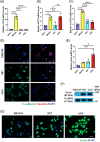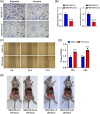Zyxin inhibits the epithelial-mesenchymal transition process in gastric cancer by upregulating SIRT1
- PMID: 37667739
- PMCID: PMC10475219
- DOI: 10.1002/mco2.357
Zyxin inhibits the epithelial-mesenchymal transition process in gastric cancer by upregulating SIRT1
Abstract
Tumor development relies on the stemness of cancer stem cells, which is regulated by environmental cues. Previous studies have shown that zyxin can inhibit the expression of genes for embryonic stem cell status. In the present study, the expression levels of zyxin protein in cancer tissues and adjacent noncancerous tissues from 73 gastric cancer patients with different clinical stages were analyzed by Western blot. We showed that the relative expression levels of zyxin in gastric cancer tissues (cancer tissues/adjacent tissues) were significantly downregulated in advanced clinical stages. Overexpression of zyxin inhibited the stemness and epithelial-mesenchymal transition (EMT) processes in gastric cancer cells. Zyxin also inhibited the proliferation, migration, and invasion but increased the sensitivity of cancer cells to drugs. Overexpression of zyxin in MKN45 cells inhibited tumor growth in nude mice. We show that the interactions between zyxin and SIRT1 led to the upregulation of SIRT1, reduced acetylation levels of histone H3 K9 and K23, decreased transcription levels of SNAI 1/2, and inhibition of the EMT process. This study demonstrated that zyxin negatively regulates the progression of gastric cancer by inhibiting the stemness of cancer stem cells and EMT. Our findings shed new light on the pathogenesis of gastric cancer.
Keywords: EMT;SIRT1; acetylation; gastric cancer; zyxin.
© 2023 The Authors. MedComm published by Sichuan International Medical Exchange & Promotion Association (SCIMEA) and John Wiley & Sons Australia, Ltd.
Conflict of interest statement
The authors declare no conflict of interest.
Figures








Similar articles
-
DAXX inhibits cancer stemness and epithelial-mesenchymal transition in gastric cancer.Br J Cancer. 2020 May;122(10):1477-1485. doi: 10.1038/s41416-020-0800-3. Epub 2020 Mar 23. Br J Cancer. 2020. PMID: 32203224 Free PMC article.
-
Overexpression of negative regulator of ubiquitin-like proteins 1 (NUB1) inhibits proliferation and invasion of gastric cancer cells through upregulation of p27Kip1 and inhibition of epithelial-mesenchymal transition.Pathol Res Pract. 2020 Aug;216(8):153002. doi: 10.1016/j.prp.2020.153002. Epub 2020 May 16. Pathol Res Pract. 2020. PMID: 32703484
-
N-Myc-interacting protein (NMI) negatively regulates epithelial-mesenchymal transition by inhibiting the acetylation of NF-κB/p65.Cancer Lett. 2016 Jun 28;376(1):22-33. doi: 10.1016/j.canlet.2016.02.015. Epub 2016 Mar 21. Cancer Lett. 2016. PMID: 27012186
-
NANOGP8 is the key regulator of stemness, EMT, Wnt pathway, chemoresistance, and other malignant phenotypes in gastric cancer cells.PLoS One. 2018 Apr 24;13(4):e0192436. doi: 10.1371/journal.pone.0192436. eCollection 2018. PLoS One. 2018. PMID: 29689047 Free PMC article.
-
Narrower insight to SIRT1 role in cancer: A potential therapeutic target to control epithelial-mesenchymal transition in cancer cells.J Cell Physiol. 2018 Jun;233(6):4443-4457. doi: 10.1002/jcp.26302. Epub 2018 Jan 15. J Cell Physiol. 2018. PMID: 29194618 Review.
Cited by
-
Down Expression of Zyxin is Associated with Down Expression of p53 in Colorectal Cancer.Int J Mol Cell Med. 2025;14(1):461-471. doi: 10.22088/IJMCM.BUMS.14.1.462. Int J Mol Cell Med. 2025. PMID: 40123589 Free PMC article.
-
Targeting sirtuins for cancer therapy: epigenetics modifications and beyond.Theranostics. 2024 Oct 14;14(17):6726-6767. doi: 10.7150/thno.100667. eCollection 2024. Theranostics. 2024. PMID: 39479446 Free PMC article. Review.
-
Identification of CKAP2 as a Potential Target for Prevention of Gastric Cancer Progression: A Multi-Omics Study.Int J Mol Sci. 2025 Feb 12;26(4):1557. doi: 10.3390/ijms26041557. Int J Mol Sci. 2025. PMID: 40004022 Free PMC article.
-
CCL16 inhibits tumor proliferation and metastasis in HCC by impacting CK19 phenotype.ILIVER. 2024 May 20;3(2):100096. doi: 10.1016/j.iliver.2024.100096. eCollection 2024 Jun. ILIVER. 2024. PMID: 40636477 Free PMC article.
References
-
- Johnston FM, Beckman M. Updates on management of gastric cancer. Curr Oncol Rep. 2019;21(8):67. - PubMed
-
- Macalma T, Otte J, Hensler ME, et al. Molecular characterization of human zyxin. J Biol Chem. 1996;271(49):31470‐31478. - PubMed
-
- Nix DA, Fradelizi J, Bockholt S, et al. Targeting of zyxin to sites of actin membrane interaction and to the nucleus. J Biol Chem. 2001;276(37):34759‐34767. - PubMed
LinkOut - more resources
Full Text Sources
